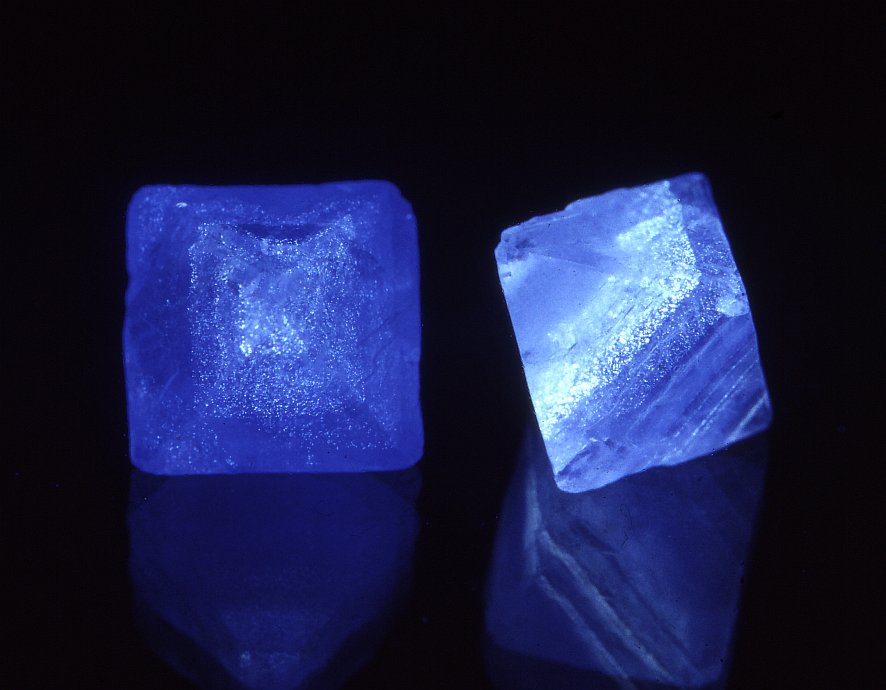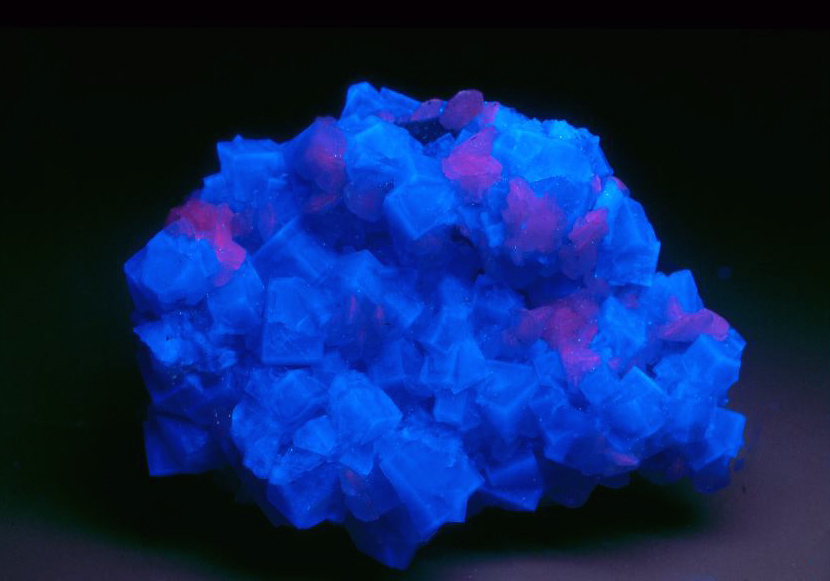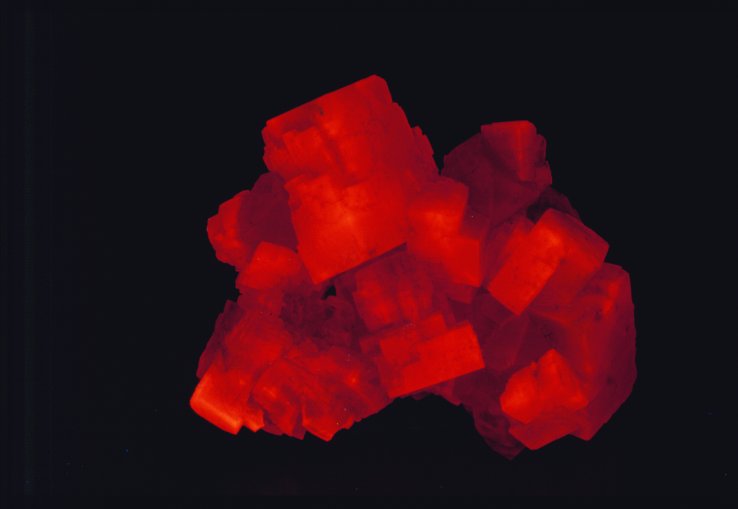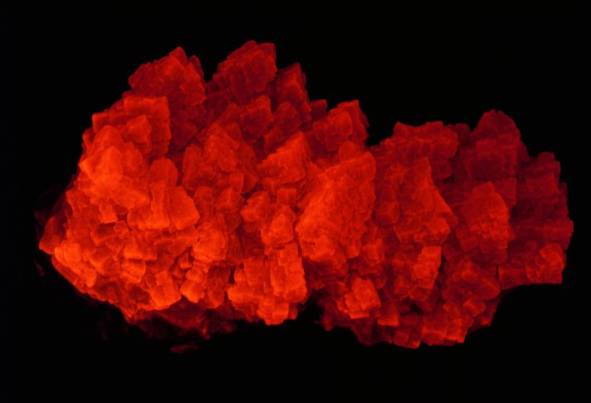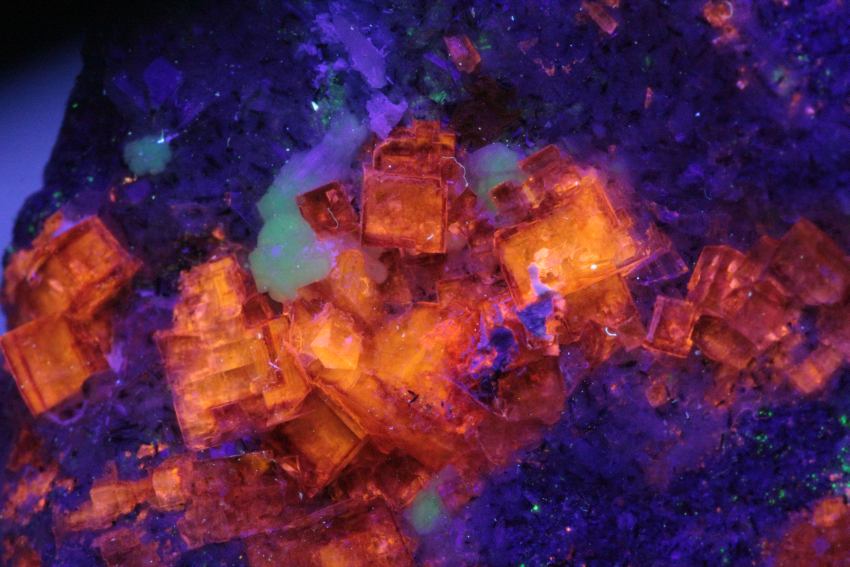http://www.mindat.org/min-1576.html
Fluorite octahedral cleavages, Cave-in-Rock, Cave-in-Rock Sub-District, Illinois - Kentucky Fluorspar District, Hardin Co., Illinois, USA (http://www.mindat.org/loc-3753.html)
Activator blue fluorescence: Eu2+ partially replacing Ca2+
Activator golden yellow fluorescence: inclusions of droplets of brine from which the fluorite grew. Possibly with some contribution of organic matter.
http://www.mindat.org/min-1576.html
Fluorite: Hammam-Zriba Mine, Zriba-Village, Zaghouan Governorate, Tunisia (http://www.mindat.org/loc-26782.html)
Activator light blue fluorescence: organic material.
http://www.mindat.org/min-1576.html
Fluorite:Seilles, Andenne, Namur Province, Belgium (http://www.mindat.org/loc-314.html)
Activator blue fluorescence: Eu2+ replacing Ca2+
Activator red fluorescence: M-center (2F+Na+)
Specimens from collection of the KBIN in Brussels
http://www.mindat.org/min-1576.html
Fluorite: Frazer's Hush Mine, Rookhope District, Weardale, North Pennines, Co. Durham, England, UK (http://www.mindat.org/loc-1411.html)
Activator blue fluorescence fluorite: Eu2+ replacing Ca2+
Activator red fluorescence calcite: not yet investigated, probably Mn2+ and Pb2+
http://www.mindat.org/min-1804.html
Halite: Fulda, Hessen, Germany
Activator red fluorescence: Mn2+ replacing Na+ with Pb2+ as a co-activator.
http://www.mindat.org/min-1804.html
Halite: Wintershall Potash Works, Heringen, Werra valley, Hessen, Germany (http://www.mindat.org/loc-1829.html)
Activator red fluorescence: Mn2+ replacing Na+ with Pb2+ as a co-activator.
http://www.mindat.org/min-1804.html
Halite: Rudna Mine, Lubin District, Legnica, Lower Silesia, Poland (http://www.mindat.org/loc-21360.html)
Activator red fluorescence: Mn2+ replacing Na+ with Pb2+ as a co-activator.
long wave UV
Long wave UV + midrange UV
Short wave UV
http://www.mindat.org/min-4181.html
Villiaumiet: Aris Quarries, Aris, Windhoek District, Khomas Region, Namibia (http://www.mindat.org/loc-7687.html)
Activator orange fluorescence: Intrinsic: M-centers (M-center = 2 F-centers + M+ (Na+, H+ etc.))
long wave UV
long wave UV
Short wave UV
Short wave UV
Short wave UV
https://www.mindat.org/min-4371.html
Fluorite var.: Yttrofluorite: (https://www.mindat.org/loc-192692.html)
The fluorescence is caused by rare earth elements that partially replace calcium. Yttrium itself does not partake in this fluorescence, but it is the 'main contaminant'. Check out the spectrum for more information about this fluorescence.
White light long wave UV short wave UV
Fluorite octahedral cleavages
Fluorite
Fluorite
Fluorite
Halite
Halite
Halite
Villiaumiet
Fluorite var. Yttrofluorite
Creedite
White light and Midrange UV resp.
Creedite:
Navidad Mine?, Abasolo, Rodeo, Mun. de Rodeo, Durango, Mexico
Creedite is not generally known for its fluorescence. It doensn't fluoresce consistently and when it does, it's not always for the same reason. Specimens from La Paz, Bolivia, in my collection fluoresce a lot like calcite and gypsum: light blue-green. This is usually caused by some organic matter, mostly humic acids. This creedite specimen from Durango fluoresces a clear violet-blue, clearly different from the blue-green fluorescence of the Bolivian specimen. Both specimens have a distinct greenish phosphorescence, which is a clear indication that they both contain polycyclic aromatic hydrocarbons (humic acids). It appears that the Mexican specimen also contains some gadolinium, cerium and europium that account for a violet-blue fluorescence. In this specimen, the ratio between the violet-blue and the bleu-green fluorescence sways towards the violet blue, but both are present. Go see the spectrum for more details.

Creedite
Creedite can apparently fluoresce due to more than one activator. However, specimens from China manage to pleasantly surprise us. They are found in the hilly area of Qinglong County, where locals look for them in the abundant caves and hollows. The lush vegetation and porous soil make it easy to incorporate humic acids and other organic plant residues into the creedite crystals (see photos).
Some crystal groups are therefore colored brown and fluoresce strongly blue-green under UV. I received a number of specimens from my e-friend Hercule Shen, which show very different fluorescence colors. One of them shows no less than three different colors in long wave UV, 365 nm.
1) White : The spectrum shows peaks of organic fluorescence/phosphorescence around 450 nm. A strong peak around 490 nm could indicate the presence of titanium as [TiO6]8-. No analyses have been carried out to confirm this, but ilmenite(Fe2+TiO3) is found in the site, which makes the presence of titanium in creedite plausible.
2) Blue : an emission peak around 410 nm seems to point to the presence of trivalent cerium. The peak has been somewhat widened by the underlying emissions of the organic matter. Here too we see a peak of [TiO6]8- but this peak has also widened and shifted a bit, probably due to the presence of divalent europium that likes to fluoresce in that wavelength range.
3) Pink : around 570 nm we see a fairly sharp peak that is most likely caused by divalent manganese that replaces some calcium. Here, too, the emission of titanium is prominent. This reduces the saturation of the red Mn2+emission to a pale pink.
So you see, creedite is a real chameleon when it comes to fluorescence.
